
Equipment
Truck Tech: May 2014
With all the snow Canadians endured between November and April, it’s important to do the necessary maintenance on our apparatuses to prevent problems caused by the salt, sand and brine used on our roadways.
April 24, 2014
By Chris Dennis
With all the snow Canadians endured between November and April, it’s important to do the necessary maintenance on our apparatuses to prevent problems caused by the salt, sand and brine used on our roadways.
Before we discuss ways to keep the trucks in shape, here is another spring maintenance tip. In the February 2013 issue of Fire Fighting in Canada, I suggested you change the gasoline in your gas-powered tools at the same time as you change the batteries in your smoke alarms and carbon monoxide detectors. If you have not done that yet, here is your reminder: winter fuel does not work well in the warmer weather. The octane levels and fuel additives are different from winter to summer. The same should be said about diesel fuel. If your department does not go through a lot of fuel, then an additive with a higher cetane level with a built-in lubricant and emulsifier should be added to help prolong the winter diesel until you can freshen it up. Remove all the gasoline from your firefighting equipment as well as your winter gas-powered equipment and top up those two-stroke and four-stroke engines with the fuel mixture and octane levels recommended by the original equipment manufacturer.
Now, let’s talk about rust. Where there are below-zero temperatures, things freeze. When this happens, de-icing materials are spread over roadways. Over the years, the environment has dictated what products are used to melt snow and ice so that the ecosystem is not damaged and so we have the safest conditions possible with the ever-changing temperatures. Many kinds of de-icing materials have been used but the one that seems to work best here in southwestern Ontario is salt. Salt causes early rust and corrosion. Fire trucks are made of many materials – aluminum, stainless steel, plastic and iron products – and will corrode. Even the copper inside the wiring harnesses is prone to early corrosion.
Some of the photos I have provided are of parts of trucks that are just three years old and had been rust-protected every fall. We cannot seem to beat this corrosion demon. The mix used here in southwestern Ontario is salt and urea or calcium, which form a liquid slurry known as brine.
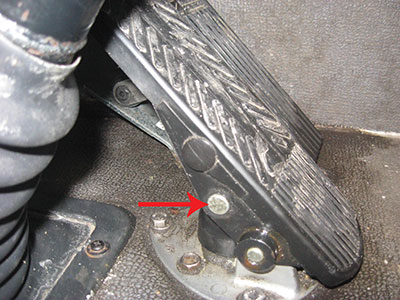
|
|
| Photo 1: A steel pin fits through an eyelet in a brake pedal, acting as a pivot point for when the brake pedal is depressed and released. This is also where a spray lubricant should be applied to prevent corrosion during the winter. All photos by Chris Dennis |
|
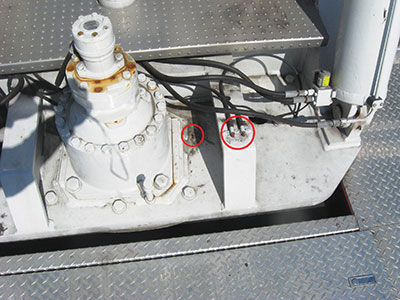 |
|
| Photo 2: The circles indicate the grease points on an aerial ladder where grease should be applied so that it can spread throughout the aerial. |
|
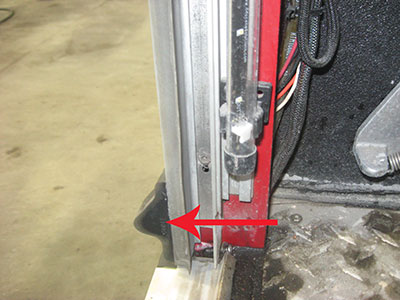 |
|
| Photo 3: While this roll-up door switch looks like a simple hunk of rubber that secures the door, it is actually an electronic switch that also alerts the truck driver if the door is not properly closed. |
|
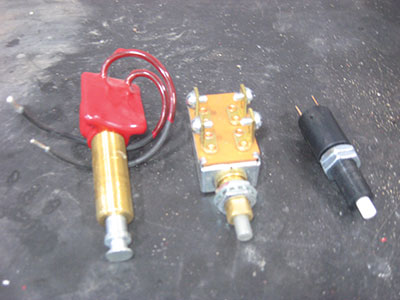 |
|
| Photo 4: Trucks that have barn-style doors that swing outward or upward are often fastened with a pin-style devices. These pins also alert the truck operator if the door is not properly closed. |
|
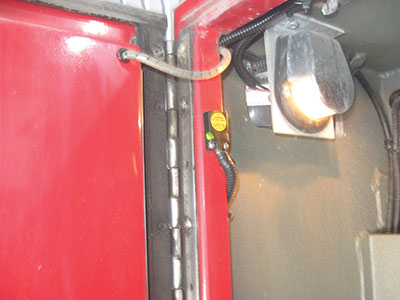 |
|
| Photo 5: Proximity switches are in direct line with the salt-water spray coming off of the truck’s tires in the winter. These switches should be inspected frequently for over-heating and corrosion.
|
|
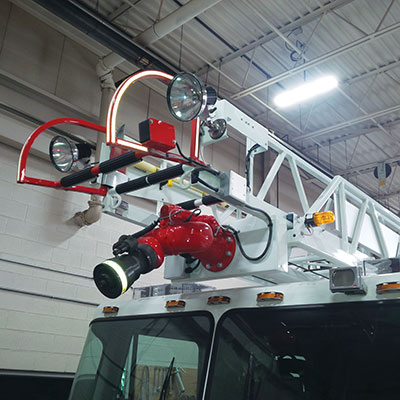 |
|
| On an aerial truck, the winter salt-snow-water mix coats the monitor and nozzle and begins to flow down the fly section and the main bed. All these areas should be cleaned with mild soap and water more frequently during the winter months. All photos by Chris Dennis |
Brine is easy to detect. Brine is a liquid sprayed onto the roadway by what looks like a liquid fertilizer spreader on steroids. This machine leaves multiple lines on the road, as if somebody dragged a rake across the pavement; when the ice begins to melt, it quickly turns to water and washes into the next line of brine, naturally spreading this slurry all over the roads and inside the fender wells, on our boots and into the cab, the lighting and the wiring harnesses. This brine is so efficient that, when it dries, it lays dormant until it’s wet again, like a Gremlin. Then the brine starts eating away at our equipment again, even when temperatures are above zero.
Five years ago, Vaughan Fire & Rescue Services put four new trucks on the road. The trucks were rust protected and have been rust protected each year. That winter our region started to use brine. I received a phone call from a captain who said his crew had just put out a fire on the wheel of a truck. It took a minute but then it hit me: it was his pumper wheel that had caught fire. The truck was at a stoplight and was about to proceed through the intersection when crew members smelled something burning.
I proceeded to the truck’s location in our service vehicle. My roadside investigation determined the brake pedal was stuck in the applied position and the friction material had heated the brake assembly so much that the grease, oil, plastic and rubber in the area ignited. The brake pedal has a metal backing with two machined eyelets through which a steel pin fits. Those eyelets are made up of two more aluminum eyelets on the air-brake control valve and are bolted to the floor. The pin passes through the eyelets to act as a pivot point (see photo 1).
In this case, the dissimilar metals were corroded together. These valves and pedal assemblies have been used for decades, not only on custom fire trucks but also on highway rigs. I worked on Mack trucks and Freightliners for many years and these manufacturers used these same pedal assemblies long before custom fire trucks came along. The only time you won’t see this type of assembly is if the pedal assembly pivots overhead and swings down over the floor instead of through the floor.
The truck was towed back to our maintenance facility where it was disassembled. We found the pin almost welded into the aluminum. It was so badly corroded that, when we tried to take it apart, the aluminum eyelets broke off. Why did this happen then and not sooner? The only thing that had changed was this liquid that is being sprayed on the roads.
Rock salt sticks to our boots and, when mixed with wet snow, leaks down over the vehicle’s pedals, rubber floor mats and carpets; once the salt has dried, it can be washed away or vacuumed. But this is not the case with brine; it is like antifreeze. Heavier than water, brine leaks into the smallest areas and when it is dry it starts its corrosive journey.
This brake-pedal failure did not just happen at that traffic light; it had been happening over time. After every brake-pedal application, the pedal should bounce back to a non-applied position. In this case, every time the brake pedal was applied, it stayed partially applied, a bit more each a time. This happened so slowly that, despite many different drivers and a powerful engine, nobody noticed until it overheated to the point that the grease caught fire.
When that truck returned to service, the rest of the fleet was inspected; four more trucks were on their way to a failure for the same thing. The fix was simple: disassemble, clean and polish the area, and apply a lubricant that would also repel the brine. Photo 1 shows where we spray the lubricant. This has become a standard operating guideline for winter and is now done during every truck check, four times a month, from November through May.
* * *
The next items requiring winter maintenance are aerials. In Vaughan, we have five 17-metre quints, two 32-metre aerials and one 30-metre mid-mount platform. Each of the trucks, except the platform, has the monitor and nozzle mounted over the cab in the driver’s view. The platform, being a mid-mount, has the monitor and bucket at the back over the tailboard.
On a truck with an aerial, the winter salt-snow-water mix coats the monitor and the nozzle, and begins to flow down the fly sections and the main bed until it comes off the back; on a mid-mount, the turbulence at the back end wets the bucket and bucket monitor with the same liquid.
I mentioned how corrosive this slush is and how it seems to flow into everything and stick. It ends up in the nozzle, the monitor swivel points and motors, the tip light and controls, and coats any tools, ground ladders or stokes baskets that may be stored up there. I recommend cleaning all these areas with mild soap and water a lot more frequently during the winter.
In addition, a non-flammable spray-on lubricant can be used directly on the aerial. The aerial’s grease points (see photo 2) should also be lubricated more often during the winter months than what the manufacturer recommends. We use approved white water-based grease on the aerials. Pins, pivots and rollers all need to be lubed. The white grease is used for appearance as our sticks are white, plus the grease washes off with mild soap and water.
Since the aerial is greased four times a month, the liquid brine is pushed out and the area is lubricated. The cables are also infected with this stuff so they, too, need to be lubricated. It is important that you only use lubricant recommended by the apparatus builder on these cables and follow the builder’s cleaning instructions so as not to void warranties or prematurely ruin the cables. We use soap and water and then rinse lightly with a garden hose – not a pressure washer – before lubricating the cables with transmission fluid.
Once winter has passed, we do a major degreasing and maintenance. The truck body and compartments should be washed to get that brine out. Do not use high-pressure water near electronics or body graphics. I recommend not washing the underside or engine and transmission areas until the warm weather arrives. If you do decide to wash these areas, be sure the truck is out for maintenance so the technician can look after all the areas – such as the alternator – that should not be soaked down directly, and that need to be completely dried out before restart.
* * *
The last items to clean are the roll-up door switches (see photo 3) that alert you if the door is not closed. In most cases, the switches are built into the catch at the bottom of the roll-up door and sealed but barn-style doors may feature a pin-type switch (see photo 4). These switches, which are in direct line with the salt and spray coming off the wheels and tires, can overheat and short out. Inspect them closely for overheating and for corrosion of the wires or relays. The cab-door ajar switches and the cab door handles should be lubricated as a preventative measure.
May is the time to do some major spring cleaning so be sure that when the bad weather comes around again, you are prepared to battle this liquid metal-eating corrosive monster.
Rubber side down, my friends.
Chris Dennis is the chief mechanical officer for Vaughan Fire & Rescue Services in Ontario. He can be reached at Chris.Dennis@vaughan.ca
Print this page